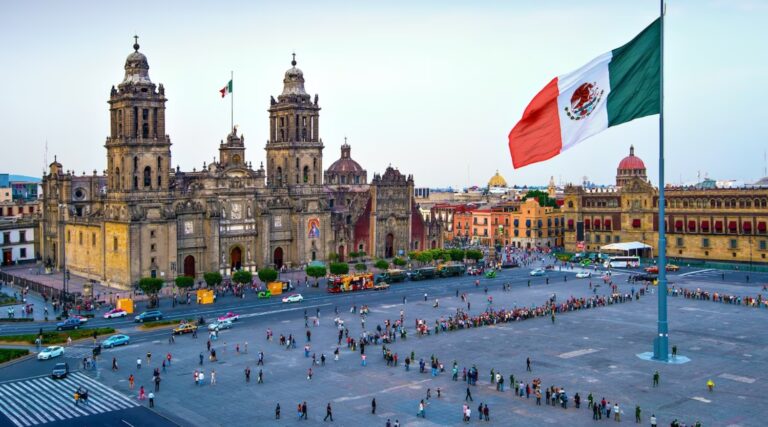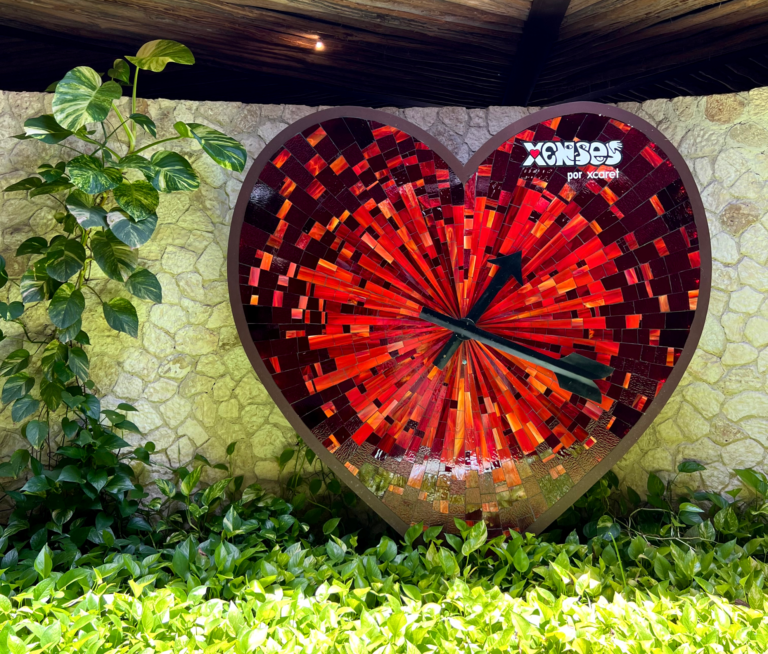
Let’s depart on a journey to explore the Day of the Dead in Mexico, or ‘El Día de Muertos.’ This article is a little different from our usual travel content, and here’s why. Last year, we had the chance to witness these incredible festivities firsthand here in Cancun, and they truly amazed us. We realized there was so much we didn’t understand about this holiday. The why’s, the what’s, and the symbolism behind it all, need to be explored. Our curiosity led us to dig deeper, and the more we learned, the more fascinated we became. This article is the result of all that research and discovery, and we can’t wait to share it with you.
Origins of the Day of the Dead in Mexico
Unlike the rather gloomy holiday of Halloween, for Mexicans, the celebration of the Day of the Dead isn’t about sadness. Instead, it’s about feeling connected to ancestors who remain part of the family even though they’ve passed on. It’s a time to honor them and keep their memory alive, believing they might visit us or send their blessings. Especially when we offer the things they loved—like food and drinks, their favorite things, as well as flowers, candles, music and prayers, all while assembling a special altar to the deceased ones.
The Day of the Dead features the sentiment that one isn’t truly dead until others forget them. It reflects the belief that the memory of a person keeps their spirit alive. This concept is a key part of the celebration’s philosophy, making it culturally relevant and accurate. The celebration of the Day of the Dead in Mexico has its roots in pre-Hispanic traditions. They saw death as a natural part of the cycle of life.

Dates and Their Significance
The Day of the Dead is not just one day, as it might seem. It is a multi-day celebration, typically spanning from October 31st to November 3rd.
While unique family and regional traditions may influence its celebrations, the heart lies in November 1st and 2nd. These dates hold profound meaning across Mexico, inviting families to reconnect with loved ones and celebrate their enduring presence in memory and spirit, filling communities with vibrant colors, fragrant aromas, and heartfelt traditions. During these days, Mexicans set up altars called ofrenda (“offering”), to remember, honor, and invite the souls of the deceased loved ones to visit. On these altars, Mexicans place photos of the departed, items they loved in life, special “bread of the dead” (Pan de Muerto), various treats and libations. They also light candles, burn incense, and decorate the altar beautifully with flowers. Mexicans give special significance to the orange marigold flowers called Cempasúchil, which traditionally honor the dead. Mexicans believe these flowers help guide the souls of the deceased back to the world of the living.
October 31st: Although this day coincides with Halloween, it’s not traditionally significant in the Day of the Dead celebrations. However, in some regions or families, it might be a time to start setting up the ofrenda and prepare for the days ahead.
November 1st: Día de Todos los Santos – “All Saints’ Day,” also known as Día de los Inocentes (Day of the Innocents) or Día de los Angelitos (Day of the Little Angels). It is the day when the souls of deceased children, Mexicans believe, visit the living world. Families adorn their ofrendas with offerings of food, candies, and toys, creating a joyous space for their little angels to visit.
November 2nd: Día de los Fieles Difuntos – “All Souls’ Day” or “Day of the Dead,” is the day when the souls of deceased adults come to visit. On this day, families place the favorite foods and drinks of their loved ones on the altar. Participants burn incense and decorate altars with marigold flowers to help guide the souls to the offerings.
Mexicans believe the spirits partake of the essence of these offerings—the aromas, warmth, and love—deriving spiritual nourishment from this feast of remembrance.
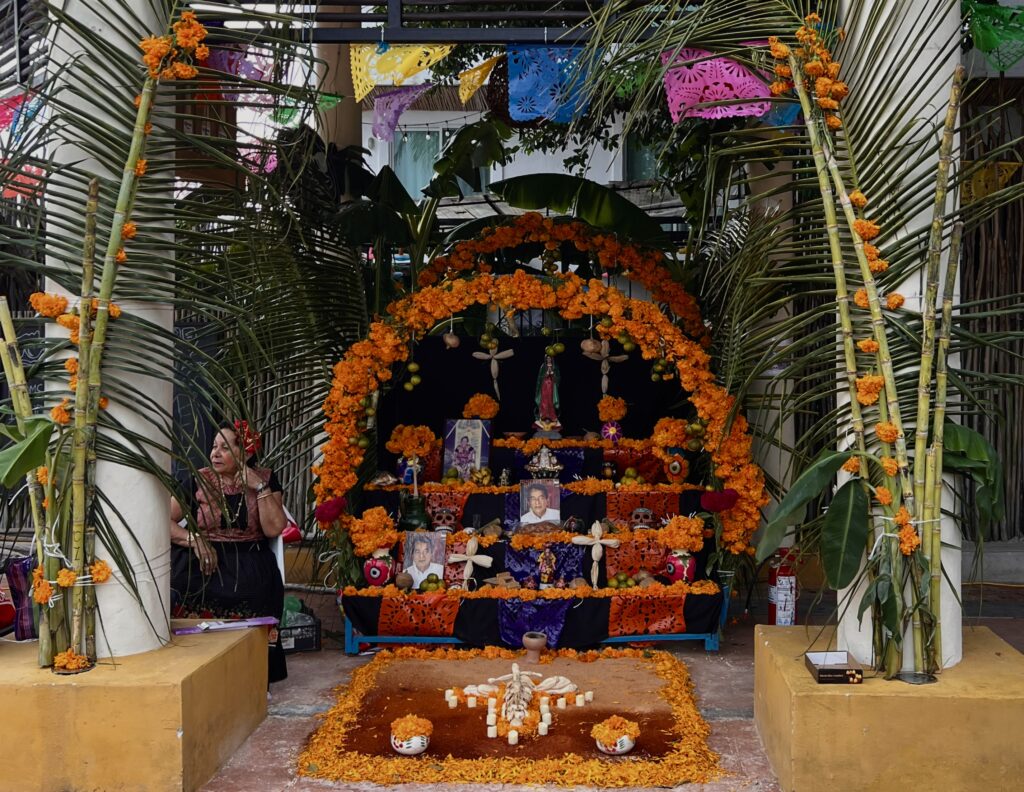
Altars and Their Details
Building an ofrenda is a deeply meaningful tradition at the heart of Day of the Dead. Preparations begin days in advance as families gather the items they’ll use to honor their departed loved ones.
Beyond its spiritual significance, the act of assembling the ofrenda is a way to keep the family close, both in spirit and in practice. It’s a time for shared memories, stories, and laughter as families work together to create a beautiful tribute to those they have lost. The ofrenda itself is rich with symbolic items, each chosen with care to honor the deceased.
Candles
In ancient times, people burned ocote pine wood as an offering. Today, candles have taken their place, symbolizing faith and hope, and lighting the way for spirits to find their path back to the afterlife in conclusion of their visit.
Water
Another element of the altar is water. Ancient Mesoamericans saw it as a life-giving element. That is why they placed water on the altar to quench the thirst of the souls after their long journey. It also represents purification and renewal.
Flowers
Flowers, particularly Cempasúchil (marigolds), are an integral part of every altar. They represent love, respect, and remembrance for those who have passed away. Their bright orange color and strong scent guide the spirits of the deceased back to the world of the living and to their families’ ofrendas. The Aztecs associated marigolds with the sun god Tonatiuh and used them in offerings to the dead.
White flowers, often placed on the ofrendas of children, signifying purity and youth.
Bread of the dead
Pan de Muerto (Bread of the Dead) is a soft, sweet bread, often shaped like a rounded bun, with a light citrus flavor. The most common form features bone-shaped pieces of dough, arranged in a circle to represent the cyclical nature of life. These “bones” may also be formed into skulls or crossbones, symbolizing the deceased rising from their graves. Atop the bread, a small, baked teardrop represents the tears of the goddess Chīmalmā for the living. The bread is typically topped with a dusting of sugar, and sometimes dyed pink for a festive touch.
Salt
Salt, a symbol of purity, is included to purify the space and prevent the corruption of the body. This ensures the spirits can safely return to the afterlife.
Incense
The burning of incense, particularly copal, is an ancient tradition rooted in rituals of veneration and protection. On the ofrenda, its aromatic smoke carries prayers and loving memories to the departed. This creates a sacred connection between the living and the deceased.
In addition to these core elements, the ofrenda might be adorned with clay dog figurines representing the Izcuintle dog that helps souls cross into the afterlife. The Xoloitzcuintli dog is more than just a unique breed; it’s a cultural symbol deeply intertwined with the beliefs and traditions surrounding the Day of the Dead in Mexico. Each element of the ofrenda is carefully chosen, reflecting both ancient traditions and modern interpretations. This is aimed at honoring the dead and ensuring their continued presence within the hearts of the living.
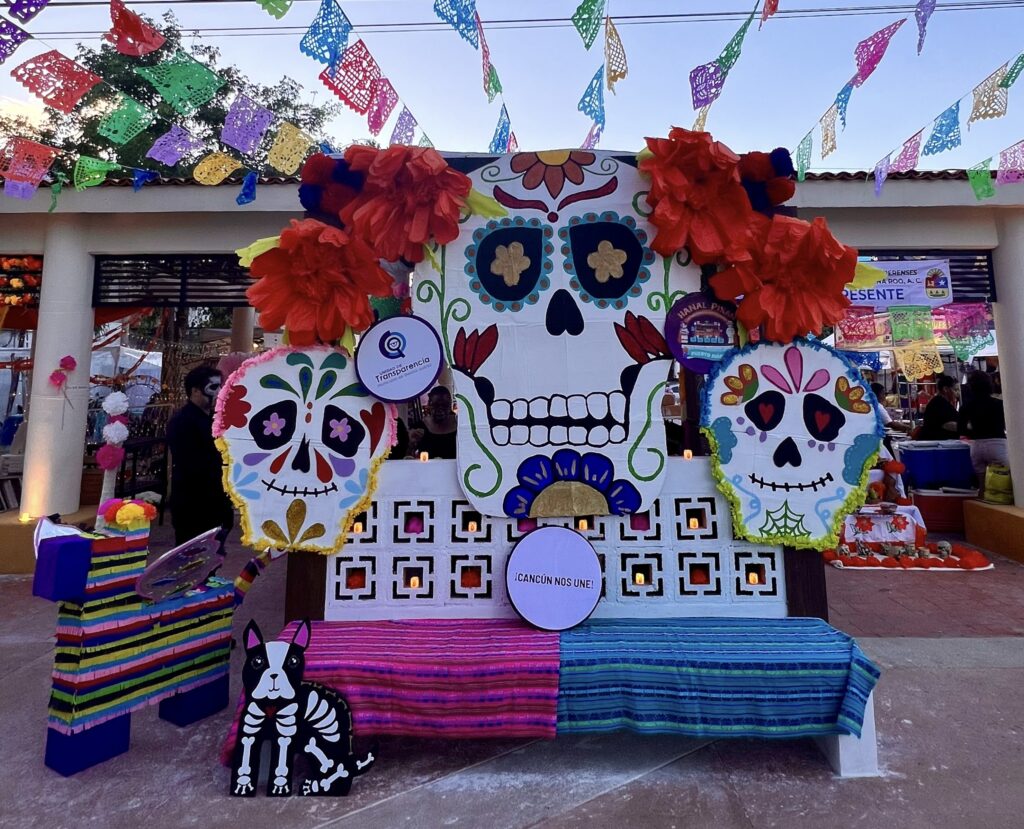
Las Calaveras
One of the most iconic elements of the Day of the Dead is las calaveras, or skulls. These skulls can be edible or decorative; people make them from sugar (a type of alfeñique) or clay using molds. They play a big role in the Mexican celebration of the Day of the Dead.
Pre-Columbian Roots and Spanish Influence
In pre-Columbian times, skulls and skeletons were often depicted in stone carvings. In some cases, they used real human skulls. They believed bones to hold life energy and power, though the way they were incorporated varied across different cultures.
With the arrival of the Spanish, the use of skulls took on another dimension. They introduced the memento mori tradition. These symbols serve as reminders of mortality, which further reinforced the connection between skulls, death, and remembrance.
Materials
Today, during the Day of the Dead in Mexico, people use all sorts of materials to make skulls and skeletons. For instance, they use sugar paste (alfeñiques), chocolate, nuts, wood, paper and more. When you give a sugar skull as a gift, you write the name of a deceased loved one in icing across the forehead of the skull on a piece of foil. This gives a more personal touch and makes the calaveras a special part of the celebration, connecting us to the history and symbolism behind these iconic images.
The act of painting a human face to resemble a skull—sometimes called face painting, “sugar skull” makeup, Catrina, or Calaca face paint—is actually not a traditional practice during the Day of the Dead, with the exception of Catrina impersonators. Traditionally, the focus of the celebration has been on the ofrendas (altars), calaveras (sugar skulls), and other symbolic elements.
However, in recent years, especially in urban areas, this type of face painting has become incredibly popular. You’ll often see people with beautifully painted faces resembling skulls, especially during Day of the Dead parades, festivals, and public events. This trend has really taken off, blending cultural pride with a modern twist and giving people a creative way to honor the holiday.
So, while it might not be part of the original traditions, skull face painting has found its place in contemporary Day of the Dead celebrations in Mexico, adding a vibrant and artistic touch to the festivities.
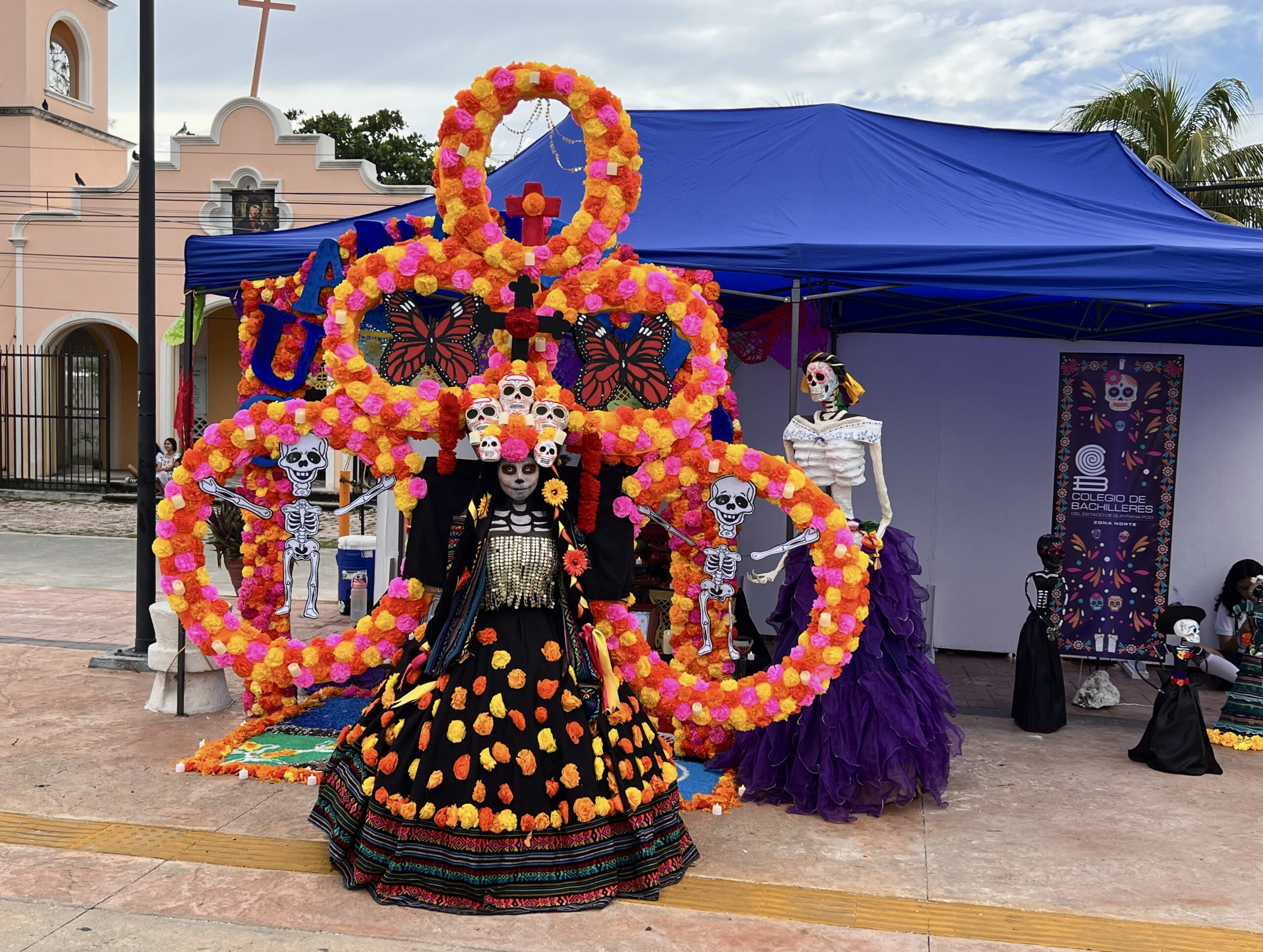
La Catrina
La Catrina, the elegantly dressed skeleton lady, is one of the most recognizable symbols of Day of the Dead. Her story is a fascinating blend of ancient mythology and social commentary, reflecting a unique period in Mexican history.
The Story Behind
While her origins may be traced to Mictecacihuatl, the Aztec goddess of death (also known as the Lady of the Dead), her modern representation emerged in the early 20th century during the presidency of Porfirio Díaz, with the work of Jose Guadelupe Posada.
During this time, locals valued European ideals and the gap between the rich and poor was widening. José Guadalupe Posada, a talented artist of the time, used his art to critique the social injustices he witnessed.
He created satirical prints called calaveras, which depicted skeletons and skulls dressed in fancy European-style clothing. These prints highlighted the emptiness of a society focused on wealth and foreign trends.
His most famous creation, La Catrina, a skull with a fancy European-style hat, perfectly captured this criticism. Through his art, Posada reminded people that death comes to everyone, regardless of wealth or status. His work connected with Mexico’s long history of honoring death, emphasizing that life is short and people should live genuinely.
Sadly, Posada wasn’t very famous when he was alive and died in 1913 without much recognition. But his work, especially La Catrina, has become incredibly popular since then.
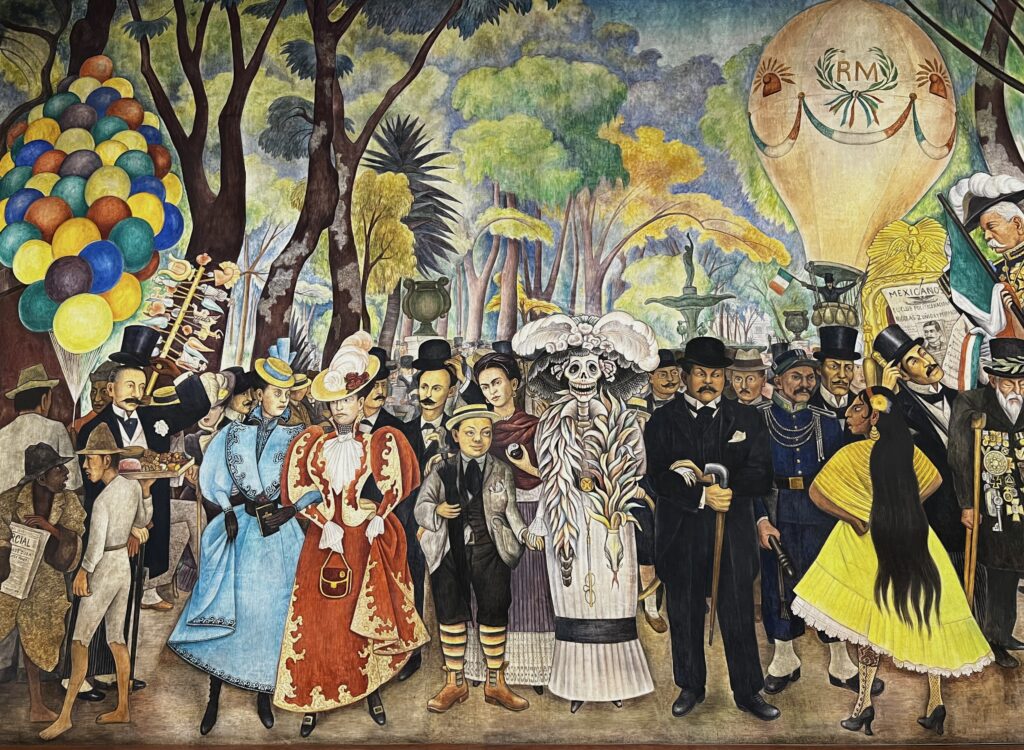
Resurrection by Diego Rivera
Years after Posada’s death, the artist Diego Rivera revived La Catrina’s popularity. He included her in his 1947 mural, “Dream of a Sunday Afternoon in the Alameda Central” (Sueño de una tarde dominical en la Alameda Central), located in Mexico City. This large mural shows over 400 years of Mexican history. In it, a young Diego Rivera holds hands with La Catrina, and his wife, Frida Kahlo, stands behind them. This helped establish La Catrina as an important symbol of Mexican identity and Day of the Dead. Rivera’s painting showed that she was more than just a funny cartoon; she represented Mexico’s history and culture.
Since then, La Catrina has become a beloved symbol of Day of the Dead. You can see her in homes, on altars, and in public celebrations. This reminds people that death is a natural part of life. La Catrina’s story shows how art can shape culture, and she continues to inspire people today.
Nowadays, the parade of people dressed as Catrinas is usually the culminating and much awaited moment of the Day of the Dead celebration.
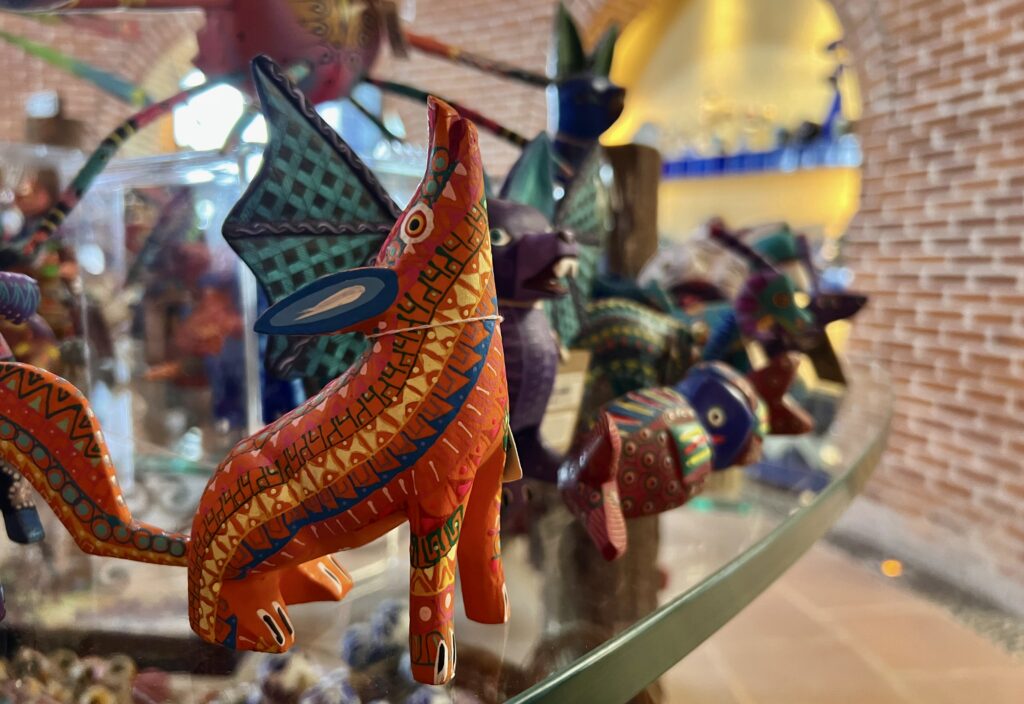
Spirit Animals for the Day of the Dead in Mexico
If you’ve been to Mexico, you may have come across brightly colored figurines in gift shops known as alebrijes. These fantastical creatures are often a fusion of different animals, known for their vibrant colors, intricate patterns, and whimsical forms. Alebrijes are a relatively recent addition to Mexican folk art, originating in the 1930s. Their original creator was Pedro Linares, a craftsman from Mexico City, who claimed to have dreamt of these fantastical creatures during a fever.
The tradition of making alebrijes soon spread to other parts of Mexico, particularly Oaxaca. Local artisans began crafting them from wood, adding another dimension to this unique art form. Today, people make alebrijes from various materials, including papier-mâché, wood, and clay.
While alebrijes are not traditionally part of the Day of the Dead celebrations or ofrendas, some people have begun to incorporate them into their altars as decorative elements or modern symbols of protection and guidance. Although they weren’t originally considered spiritual guardians in Mexican culture, in recent years, alebrijes have come to represent hope and joy for some during the Day of the Dead.
These colorful creatures serve as a reminder that death is just a step in the cycle of life, and that our loved ones who have passed away remain alive in our hearts. Even though this association is a modern adaptation, the presence of alebrijes in the festivities adds to the vibrant celebration of life and remembrance that characterizes Día de Muertos.
Understanding the meaning behind the Day of the Dead in Mexico not only deepens appreciation for Mexican culture but also offers a more profound perspective on life, death, and the human experience. It embraces the idea that death is not an end but a transition, and that love, joy, and remembrance keep our loved ones ever-present.
Interested in discovering more about Mexico and its rich culture? Check out our article: 22 Interesting Facts About Mexico!

